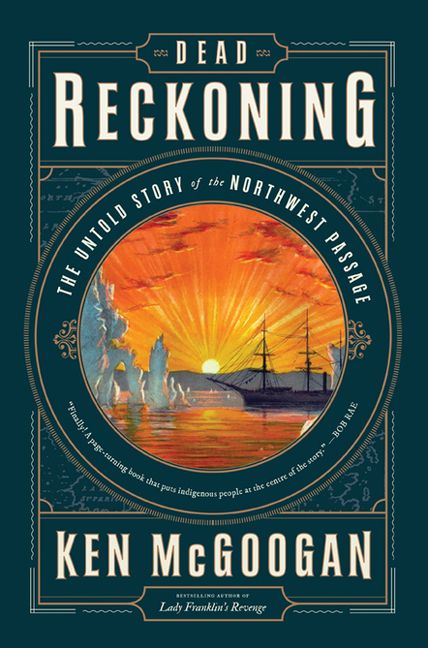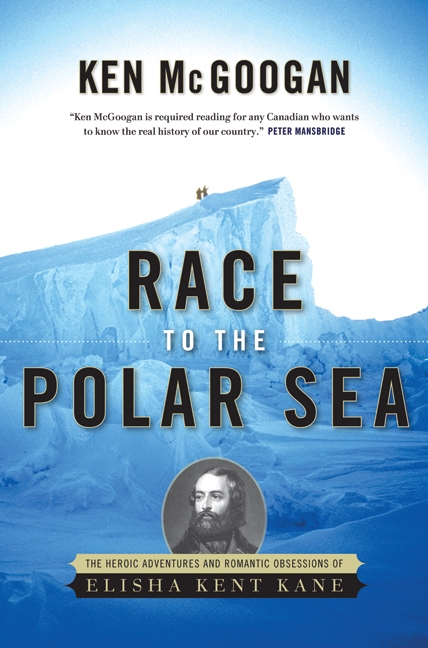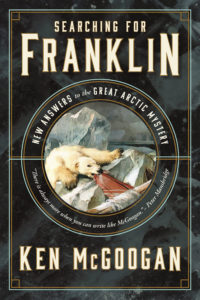Dead Reckoning

Overview
With this book, Ken McGoogan caps a quintet of works about Arctic exploration. Orthodox history celebrates such naval figures as John Franklin, Edward Parry and James Clark Ross. Dead Reckoning tells their stories but also encompasses such forgotten heroes as Thanadelthur, Akaitcho, Tattanoeuck, Ouligbuck, Tookoolito and Ebierbing, to name just a few. Without the assistance of the Inuit, Franklin’s recently discovered ships, Erebus and Terror, would still be lying undiscovered at the bottom of the polar sea.
Dead Reckoning ranges from the sixteenth century to the present day, looks at climate change and the politics of the Northwest Passage, and recognizes the cultural diversity of a centuries-old quest. Informed by the author’s own adventuring in the Arctic, and illustrated throughout, the book is a colorful, multi-dimensional saga that demolishes myths, exposes pretenders, and celebrates unsung heroes. For international readers, it sets out a new story of Arctic discovery. For Canadians, it brings that story home.
Read MoreLady Franklin’s Revenge

Overview
(This book won the University of British Columbia Medal for Canadian History. Soon afterwards, Ken received the Pierre Berton Award for History)
Lady Franklin’s Revenge tells the story of a remarkable British woman who, denied a constructive role by the male-dominated society into which she was born, took her revenge in mid-life by seizing control of that most masculine of enterprises, Arctic exploration, and shaping its history to her own ends. Born into a world that decreed her place to be in the home, Jane Franklin (1791-1875) rebelled without ever declaring it. Arguably the greatest woman traveler of the age, she rode a donkey into Nazareth, sailed a rat-infested boat up the Nile River, and beat her way through the Tasmanian bush. She rode elephants in Rajasthan, scrambled up volcanoes in Hawaii, and, at age seventy, circumnavigated the globe in steamers and rough sailing ships.
When her husband, Sir John Franklin, disappeared into the Arctic in 1845 while searching for the Northwest Passage, the dauntless Jane launched an unprecedented, twelve-year search. She raised funds, organized expeditions, stipulated routes, appointed captains, and dispatched ships, so contributing more to the discovery and mapping of northern North America than any other individual. Having failed to rescue the ill-fated Franklin, Jane worked through powerful male surrogates – among them Charles Dickens, Benjamin Disraeli, and the American magnate Henry Grinnell – to eradicate inconvenient truths, create a legend of her hapless husband, and change the course of Arctic history.
Fatal Passage

Overview
Fatal Passage tells the story of Dr. John Rae, an unsung Arctic fur-trader who solved the two great mysteries of nineteenth-century Arctic exploration. Rae discovered both the final link in the Northwest Passage and the fate of the lost expedition of Sir John Franklin, whose final survivors resorted to cannibalism. Because he revealed that truth to Victorian England, Rae was vilified and virtually erased from history.
A national bestseller, Fatal Passage won the Writers’ Trust of Canada Drainie-Taylor Biography Prize, the Canadian Authors’ Association Lela Common Award for Canadian History, the Grant MacEwan Author’s Award, and an American Christopher Award for a work of artistic excellence that “affirms the highest values of the human spirit.” Film-maker John Walker turned the book into an award-winning docudrama called Passage, which aired on BBC and History Channel.
Read MoreAncient Mariner

Overview
In 1757, when twelve-year-old Samuel Hearne joined the Royal Navy as an apprentice to the famous Fighting Captain Samuel Hood, he embarked on a life of high adventure. This courageous young sailor would become the first European to reach the Arctic coast of North America, during an unprecedented, three-year odyssey in the forbidding Barren Lands.
In this colourful, real-life saga, Ken McGoogan paints a vivid word-picture of life in the eighteenth-century, taking readers on and off the wooden sailing ships, through Dr. Johnson’s London, a city of 5,000 coffee houses, and away to the farthest reaches of North America. After serving as a midshipman during the Seven Years War, Hearne joined the Hudson’s Bay Company and was posted to Prince of Wales Fort at Churchill on Hudson Bay. From there, the ambitious young man embarked on an overland quest for a fabled copper mine – and also to discover the Northwest Passage.
In his epic journal, best known as A Journey to the Northern Ocean, Hearne details his sub-arctic odyssey, which was marked by hardship, near-starvation and culture shock. Joining forces with Matonabbee, a legendary Chipewyan Dene leader, and closely observing the people, wildlife and terrain as he went, Hearne traveled more than 3500 miles, mostly on foot – incidentally demonstrating that, to thrive in the north, Europeans needed only to apprentice themselves to the native peoples. His journey culminated in the infamous massacre of Inuit at “Bloody Falls” – an event that changed Hearne, a reluctant eye-witness, forever.
Ancient Mariner demonstrates that Hearne was a pioneering naturalist, anthropologist, and story-teller, and also offers insights into his emotional life: his loyalty to friends, his devotion to his mother, his tragic love for his wife Mary Norton, certainly the most arresting tale of star-crossed love in exploration history. In a fascinating bit of literary detective work, McGoogan determined that Samuel Hearne, having returned to London to live out his final days, met the poet Samuel Taylor Coleridge, almost certainly inspiring the figure of the haunted sailor in the “The Rime of the Ancient Mariner.”
Read MoreRace to the Polar Sea

Overview
Race to the Polar Sea tells the true story of a remarkable American explorer who went in search of an Open Polar Sea at the top of the world, hoping to rescue survivors from the lost expedition of Sir John Franklin. In the 1850s, after sailing farther north than anyone else, Elisha Kent Kane got trapped in the pack ice off Greenland. Having discovered "the American route to the North Pole," he forged a unique, life-saving alliance with the Inuit. Over two years, he battled starvation, disease, and a near mutiny before abandoning ship to lead an astounding escape in sleds and small boats. Ken McGoogan celebrated its publication by sailing into Kane Basin with Adventure Canada – a voyage that inspired a travel article and a video.
Read MoreSearching for Franklin

Why did I write this 'big Franklin book?'
By Ken McGoogan
Early afternoon in Gjoa Haven, everyone gravitates to Qiqirtaq High School, a big modern building, for a cultural presentation. September 2017. I'm sailing in the Northwest Passage with Adventure Canada as a resource historian, giving talks as we travel. I've been rambling around Gjoa looking for Louie Kamookak, my old friend and fellow traveler.
As I take a seat on one of the tiered benches overlooking the gym, finally I spot him in a crowd of standees. He catches my eye and gestures toward the main entrance and we make our way into the hallway. After greeting each other, we fall to our usual kibbitzing. By now, age fifty-nine, Louie is widely recognized as the leading Inuit historian of his generation. We commiserate about not getting to meet each other, as planned, at the Erebus site.
He mentions speaking recently with a local Elder, interviewing him, and I say, "Wait, aren't you an Elder yet? When are you going to become an Elder?"
"I'm still too young," he says, grinning. "Way too young."
Then he comes back at me: "When are you going to write your big Franklin book?"
"My big Franklin book?"
"You've written about everybody else. Don't you think it's time?"
"No way." I shake my head. "I'm still too young."
Together we laugh.
That was our last face-to-face meeting - Louie jokingly complaining that although I had published five books about Arctic exploration, I had yet to focus on the most famous northern explorer of them all: Sir John Franklin. I wrote this book to rectify that omission. Searching for Franklin - merely average in size, Louie, sorry! - challenges old orthodoxies, incorporates recent discoveries, and interweaves two main narratives.
The first treats the Royal Navy's Arctic Overland expedition of 1819-22, during which Franklin rejected the advice of Dene and Metis leaders and lost 11 of his 20 men to exhaustion, starvation, and murder. The second discovers a startling new answer to that greatest of Arctic mysteries: what was the root cause of the catastrophe - history's worst Arctic disaster - that engulfed the two-ship expedition on which Franklin embarked in 1845. What we see here is the front cover. Douglas & McIntyre will publish the book this autumn. Pub date: Oct. 7, 2023. More details soon!
Read More